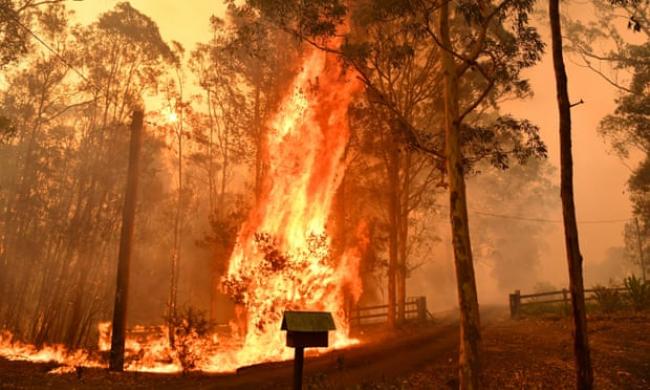Articles Menu

Bureau forecasts heatwave while fire authorities say dozens of fires will burn across Australia for weeks
• How big are the fires burning on the east coast of Australia?
• ‘Get the hell out of Dodge’: the fight to save homes from the NSW central coast inferno
Dec. 7, 2019
Dozens of fires will burn across Australia for weeks, fire authorities say, including a “mega-fire”, already the size of greater Sydney, that is too big to put out.
As of Saturday night, more than 100 fires were burning across the state of New South Wales, 18 of which potentially threatened lives and homes. More than 40 were burning across Queensland.
Already this fire season, six people have died and more than 1,000 homes have been lost across NSW and Queensland.
Volunteer fire crews, many of whom have been fighting fires for weeks, were trying to put in containment lines ahead of worsening conditions this week, with temperatures forecast to rise into the low 40s by Tuesday.
The largest conflagration, the “mega fire” at Gospers Mountain near Sydney’s north-western outskirts, was likely to burn for weeks until substantial rain falls, likely at the end of January or early February.
The NSW Bureau of Meteorology said the largest fires simply could not be extinguished by water-bombing aircraft or firefighting crews on the ground.
“The massive NSW fires are in some cases just too big to put out at the moment … they’re pumping out vast amounts of smoke which is filling the air, turning the sky orange and even appearing like significant rain on our radars,” the bureau said.
The bureau has forecast a grim week ahead, with strong winds forecast for fire-affected areas and no rain relief in sight. A months-long drought in eastern Australia has left bushland tinder dry and prone to ignition, especially from dry lightning strikes.
Temperatures are expected to reach 43C in western Sydney, and 44C in the Hunter region immediately north of Australia’s largest city.
Temperatures will also soar in the state’s north-west, where they are forecast to hit 44C in Bourke and 43C in Colbar.
In Queensland late on Saturday, a shipping container filled with fireworks exploded and residents were forced to flee their homes as an unpredictable fire threatened homes in Bundamba, on the outskirts of the state capital, Brisbane.
Residents within an three-kilometre-squared exclusion zone were ordered out as the firefront was waterbombed but fire crews warned they might not be able to stop the fast-moving blaze.
The chief scientist at the Australian Royal Society for the Prevention of Cruelty to Animals, Dr Bidda Jones, said that, beyond the human cost of the fires, the widespread blazes would have a “major impact of biodiversity”.
“Depending on the intensity of the fire, it will have had a massive impact on wildlife,” she said. “And not just on those iconic species like koalas. You have to think of this in terms of how it affects the entire ecosystem.
“You have animals relying on the eucalyptus trees for their primary diet – greater gliders are another example of that. Then you have a whole range of other species living off nectar or the insects in that environment, and there’s going to be a considerable loss of insect life in those fires.”
Jones said animals often preferred old large trees for nesting, the trees most likely to be destroyed by the fires.
“And then with fires that have been burning even at low intensity, leaf litter and all the understorey is gone. That’s providing food and refuge to animals there and the animals they would eat.
“So if you look at the overall picture … the damage has been so extensive, it’s going to have a major impact on biodiversity.”
Much of Jones’s own property, which backed on to national park at Braidwood near the Australian capital, Canberra, was lost to fires this week.
“At this point almost all of that has been burnt, all of that continues forest, up to 31,000 hectares,” she said. “The big trees are still there and we have greater gliders that live in the forest, as well as powerful owls.
“So I’m hoping that they’ll be OK. They’ll have lost nesting holes because the big trees have fallen and it’s the big old trees that have the nesting holes.”
Jones’s property was home to a huge variety of birds, as well as eastern grey kangaroos, swamp wallabies and red wallabies.
“We were going out and meeting kangaroos and red neck wallabies that were moving away from the fire,” she said. “A lot of wombats, I’m not sure what they’re going to eat. All of the forest floor, any grass any shrubs, are gone.”
Jones said her rainfall records showed last month to be the driest November in 40 years. The November average is about 100ml but this year it was 18ml.
The role of climate change in contributing to Australia’s unusually early and fierce fire season has been the subject of acute political debate. The federal government has refused to concede that climate change – and in particular Australia’s continued rising carbon emissions and massive fossil fuel exports – have played any role in the current fire crisis.
The Australian, prime minister Scott Morrison, has consistently said it was “no credible scientific evidence” linking climate change with the fires. This has been rejected by climate scientists, who have said politicians are “burying their heads in the sand while the world is literally burning around them”
“Anytime I hear ‘don’t talk about climate change’,” Jones said, “anyone in my situation has absolutely no doubt these conditions are extreme and are connected to climate change.”
[Top photo: Fire going through a fence during a bushfire in Werombi, 50km south-west of Sydney. As of Saturday night, more than 100 fires were burning in NSW and more than 40 in Queensland. Photograph: Mick Tsikas/AAP]